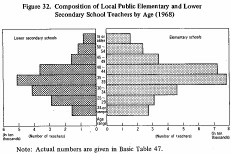| Home > Policy > White Paper, Notice, Announcement > White Paper > EDUCATIONAL STANDARDS IN JAPAN 1971 > CHAPTER |
||
Looking at the composition of teachers by qualification and academic5ackground, one notes that in prewar days and just after the war there were a number of teachers such as substitute teachers and assistant teachers having no regular qualifications. The percent of these teachers in the total, however, has decreased rapidly year-by-year with the improvement and perfecting of the teacher training system and with the expansion of teacher training universities. As of 1969,teachers without regular qualifications accounted for only 1.7% of the total in elementary schools, 0.4% in lower secondary schools and 1.8%in upper secondary schools.
As for the composition of teachers by academic background, the distribution of teachers who have completed four-year university courses or more is consider-ably unbalanced according to locality or school level. In prefectures with big cities, for example, teachers with four-years of university education or more accounted for around 40% of all the teachers in local public elementary schools, while, in primarily rural prefectures, the percentages ranged from 9 to 15%. Therefore large differences in the composition of teachers by academic background exist from area to area.

Note: Actual numbers are given in Basic Tables 46 Basic Table 46
As for the composition of teachers in local public elementary and lower secondary schools by age, the percent of teachers aged 35 to 44 ranged from 42 to46%, and the proportion of younger teachers below 29 years of age was around20% of the total. Thus there exists some distortion in the composition of teachers by age.
The cause for the distortion derives from the employment of
large numbers of new teachers after the end of World War ![]() , when the new system
of education was inaugurated, and there seems to be the possibility of great
periodic changes in the demand and supply relationship of teachers in the future.
This distortion was especially conspicuous among local public elementary school
teachers. The percent of elementary school teachers below 29 years of age serving
in schools in the rapidly growing industrial areas ranges from 29 to 37%, while,
in the areas where population is decreasing, it is less than 10%.
, when the new system
of education was inaugurated, and there seems to be the possibility of great
periodic changes in the demand and supply relationship of teachers in the future.
This distortion was especially conspicuous among local public elementary school
teachers. The percent of elementary school teachers below 29 years of age serving
in schools in the rapidly growing industrial areas ranges from 29 to 37%, while,
in the areas where population is decreasing, it is less than 10%.

Note: Actual numbers are given in Basic Table 47 Basic Table 47
As for the composition of teachers by academic background in other major countries, 67% of all the teachers in public elementary and secondary schools in the U.S.A. in 1 967 had bachelor's degrees and 28% had master's or higher than master's degrees. Recently, in some states, master's degrees have been required of prospective teachers for elementary and secondary schools, and a tendency to raise teaching qualifications are in evidence. In England and Wales, in 1967, 98% of all the teachers in public elementary and secondary schools were qualified teachers who were graduates from colleges of education or other higher education institutions. In the U.S.S.R., in 1968, 20% of the elementary school teachers were university graduates and 72% came from secondary professional schools (equivalent to Technical Colleges in Japan) and 89% of all the secondary school teachers were university graduates.
| Back to Top | MEXT HOME |